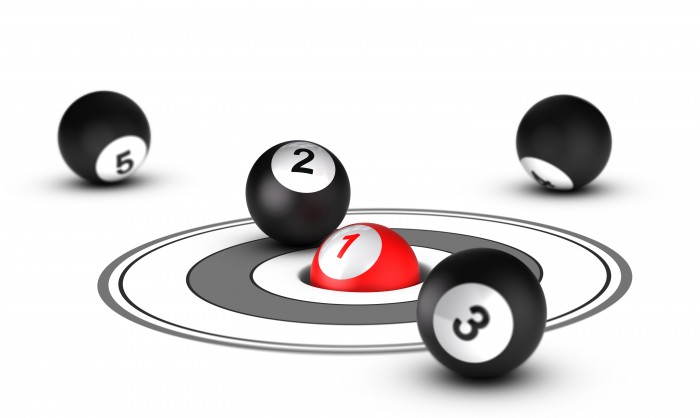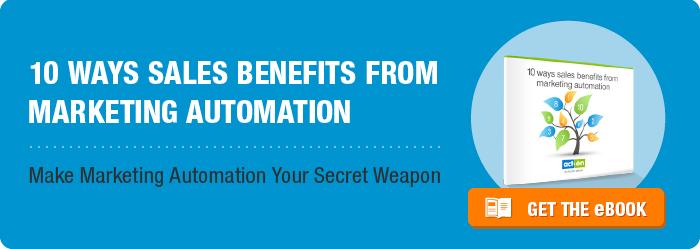 Marketing automation provides powerful tools for marketers and sales teams to build stronger relationships with customers and make better decisions for their business. But what if you have a small team? Or you’re working with limited resources? In either case, marketing automation can become a powerful ally, because it can actually reduce costs while increasing productivity. In fact, Nucleus Research found that marketing automation increases sales productivity by 14.5% and reduces marketing overhead by 12.2%. And according to Forrester Research, companies using lead nurturing (one of marketing automation’s key capabilities) generate 50% more sales-ready leads — with 33% lower cost per lead. (!)
Marketing automation provides powerful tools for marketers and sales teams to build stronger relationships with customers and make better decisions for their business. But what if you have a small team? Or you’re working with limited resources? In either case, marketing automation can become a powerful ally, because it can actually reduce costs while increasing productivity. In fact, Nucleus Research found that marketing automation increases sales productivity by 14.5% and reduces marketing overhead by 12.2%. And according to Forrester Research, companies using lead nurturing (one of marketing automation’s key capabilities) generate 50% more sales-ready leads — with 33% lower cost per lead. (!)
Act-On customers are seeing results that confirm the data. Recently, we conducted a case study with the Greater Philadelphia Chamber of Commerce (GPCC), a business networking organization with thousands of member companies representing more than 600,000 employees across three states. Like most not-for-profit organizations, GPCC spends a lot of time trying to get the most possible value from limited resources. Let’s take a look at how lead scoring, upselling and cross-selling, and advanced lead qualification strategies helped their sales and marketing teams do more with less.
1. Qualify Leads for the Sales Team
 Because marketing automation tracks prospective customers through their buying journey, marketers are better able to understand and manage prospects, and deliver qualified leads to the sales team. Sales departments can define the characteristics that indicate when a prospect is more likely to become a buyer, such as title, industry, and certain behaviors and/or actions. In turn, marketing is able to set up lead strata (such as “Marketing Qualified,” “Sales Accepted,” and “Sales Qualified”) that take the guesswork out of a lead’s status. Leads advance through these classifications automatically as they’re nurtured by marketing’s efforts, and engage in progressive buying behaviors. At the right time, marketing passes qualified leads to sales for continued engagement.
Because marketing automation tracks prospective customers through their buying journey, marketers are better able to understand and manage prospects, and deliver qualified leads to the sales team. Sales departments can define the characteristics that indicate when a prospect is more likely to become a buyer, such as title, industry, and certain behaviors and/or actions. In turn, marketing is able to set up lead strata (such as “Marketing Qualified,” “Sales Accepted,” and “Sales Qualified”) that take the guesswork out of a lead’s status. Leads advance through these classifications automatically as they’re nurtured by marketing’s efforts, and engage in progressive buying behaviors. At the right time, marketing passes qualified leads to sales for continued engagement.
It’s a system that saves time and reduces wasted effort, and it’s proven extremely effective for the GPCC. They’ve been using Act-On solutions for about a year, and according to their sales director, the platform has already paid for itself, and the GPCC’s primary concern – a diminishing number of qualified leads – is seeing significant improvement. In fact, they’ve seen a 10% increase in the number of leads generated year-over-year from their website. Formerly, all inbound form submissions were counted as leads, including the ones from current members who were just visiting the website looking for information. This distorted marketing results and interfered with targeted follow-up. Thanks to marketing automation, the teams at GPCC are quickly able to identify which form submissions are actually leads, and then turn them over to sales when the time is right.
2. Prioritize Leads with Lead Scoring; Improve Engagement
 Lead scoring is the process of assigning points to a lead based on specific behaviors and demographic characteristics, with points accumulating over time. For example, if you know that looking at your pricing page is a buying signal, you assign that action a higher score than, say, opening a newsletter. Marketing automation tracks and scores a lead’s progress through the funnel in real time. When a pre-defined scoring threshold is passed, a notification is triggered to the correct sales reps, letting them quickly prioritize hot leads and respond at the right time.
Lead scoring is the process of assigning points to a lead based on specific behaviors and demographic characteristics, with points accumulating over time. For example, if you know that looking at your pricing page is a buying signal, you assign that action a higher score than, say, opening a newsletter. Marketing automation tracks and scores a lead’s progress through the funnel in real time. When a pre-defined scoring threshold is passed, a notification is triggered to the correct sales reps, letting them quickly prioritize hot leads and respond at the right time.
Using Act-On’s powerful lead scoring capabilities,the GPCC has been able to identify strong leads based on email open and click rates as well as page visits. This helps the sales team prioritize; the team can focus on 30 warm leads instead of 300 cold ones. It saves time, reduces effort, and makes the sales team more successful. While the GPCC original goal for Act-On was to generate leads and increase sales, they quickly discovered that the email automation and lead scoring features could also be used to improve engagement for their existing members.
3. Cross-Sell and Up-Sell Current Customers
 Marketing automation reports and dashboards make it quick and convenient to review and analyze a wealth of customer intelligence, including demographics, campaign engagement, website visits, and purchase history. This information – often available in real time – is essential for identifying cross-selling and up-selling opportunities. Behavior history profiles can uncover likely follow-up sale products based on each customer’s pre-purchase and post-purchase interactions.
Marketing automation reports and dashboards make it quick and convenient to review and analyze a wealth of customer intelligence, including demographics, campaign engagement, website visits, and purchase history. This information – often available in real time – is essential for identifying cross-selling and up-selling opportunities. Behavior history profiles can uncover likely follow-up sale products based on each customer’s pre-purchase and post-purchase interactions.
Using Act-On lead scoring, the sales team at GPCC is developing a baseline of customer satisfaction as well as tracking how likely their members are to recommend the GPCC to other businesses. Measuring this kind of data and setting up targeted, timely communications is a great way to maintain loyalty and gain traction with new prospects through referrals. It also makes it possible to up-sell services to current customers like advertising opportunities and special events such as ribbon-cutting ceremonies.
Check out the Greater Philadelphia Chamber of Commerce case study study to learn more about the many ways marketing automation has helped this non-profit do more with less, and continually improve the performance of their online conversion process.
Maximizing resources is a challenge for businesses of any size. But the benefits of marketing automation for sales teams go far beyond increased productivity. Read this eBook to learn more, and find out how to drive increased visibility, faster funnels, and higher close rates.

